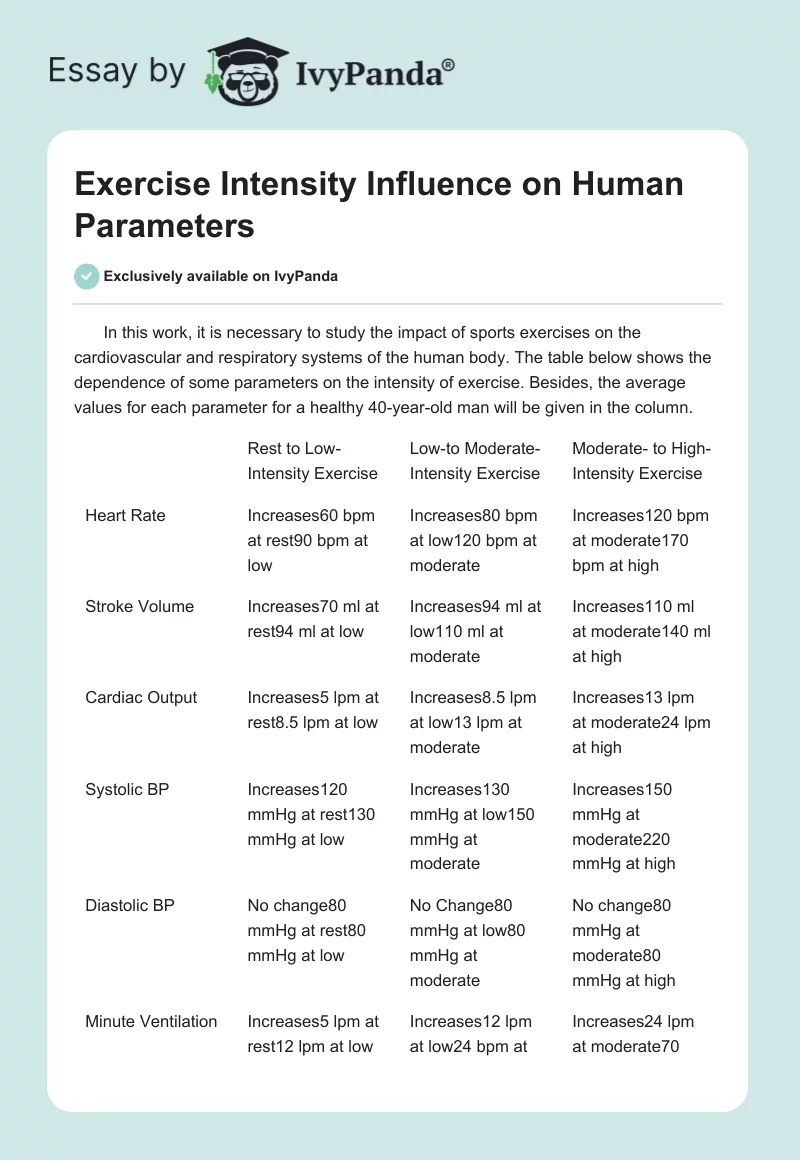In this work, it is necessary to study the impact of sports exercises on the cardiovascular and respiratory systems of the human body. The table below shows the dependence of some parameters on the intensity of exercise. Besides, the average values for each parameter for a healthy 40-year-old man will be given in the column.
The analysis of the table shows that the majority of indicators tend to increase with the intensity of physical activity. For example, the heart rate in a healthy adult person varies between 60 and 80 at rest (Draghici & Taylor, 2016). The number of heartbeats is related to the complexity of the exercise. The amount of oxygen consumed increases with the intensity of exercise, which causes the heart to contract more often and leads to increased breathing (Vaux-Bjerke, 2019). Blood is pumped faster through blood vessels, so the body needs a higher concentration of oxygen molecules for active cellular absorption.
When exercise occurs, there is a significant redistribution of cardiac output in favor of skeletal muscles at the expense of other bodies. Increased blood flow in working muscles is mainly due to local metabolic mechanisms and hemodynamic function of skeletal muscles. Practical studies show that an increase in shock volume, along with an increase in heart rate, necessarily leads to an increase in cardiac output (Morris, Walsh, Adams, & Alision, 2016). The reason for this is that the amount of blood that myocardium can release into vessels is not constant and is determined by organ requirements under specific conditions. Organs are forced to consume more blood during intense exercise.
Different sources often provide information on ideal systolic and diastolic blood pressures equal to 120 and 80 mmHg. However, in practice, each person has its norm, and fluctuations from typical figures are possible. During intensive sports activities, the systolic BP in men can rise to 220 mmHg (Caselli et al., 2016). Systolic blood pressure usually increases during exercise, while diastolic pressure either decreases or remains constant. As a result, the average blood pressure changes slightly. Its high growth due to diastolic blood pressure indicates an unbalanced regulation of hemodynamics.
Increased breathing is an apparent physiological response to physical activity. The minute ventilation increases linearly at the beginning of the exercise as the intensity of the work increases and then becomes superlinear when the maximum point is reached. Tidal Volume depends primarily on the body’s oxygen demand in the extraction of a certain amount of carbon dioxide, as well as on the condition of the respiratory muscles and the passage of the bronchus.
References
Caselli, S., Segui, A. V., Quattrini, F., Di Gacinto, B., Milan, A., Assorgi, R., & Pelliccia, A. (2016). Upper normal values of blood pressure response to exercise in Olympic athletes. American Heart Journal, 177(1), 120-128.
Draghici, A. E., & Taylor, J. A. (2016). The physiological basis and measurement of heart rate variability in humans. Journal of Physiological Anthropology, 35(1), 22.
Morris, N. R., Walsh, J., Adams, L., & Alision, J. (2016). Exercise training in COPD: What is it about intensity? Respirology, 21(7), 1185-1192.
Vaux-Bjerke, A. (2019). Why does your breathing rate increase during exercise? Web.


